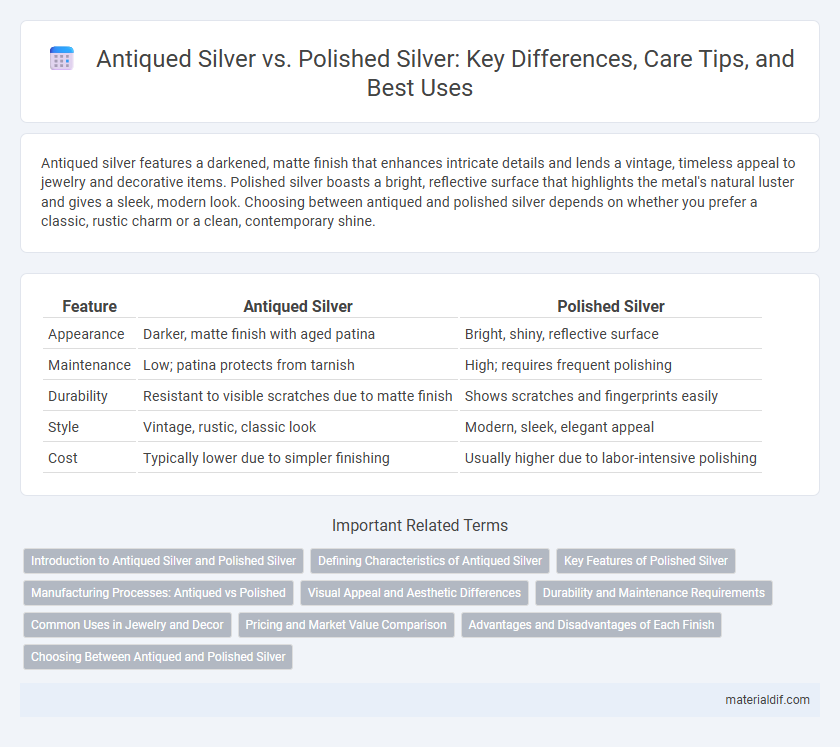Antiqued silver features a darkened, matte finish that enhances intricate details and lends a vintage, timeless appeal to jewelry and decorative items. Polished silver boasts a bright, reflective surface that highlights the metal's natural luster and gives a sleek, modern look. Choosing between antiqued and polished silver depends on whether you prefer a classic, rustic charm or a clean, contemporary shine.
Table of Comparison
| Feature | Antiqued Silver | Polished Silver |
|---|---|---|
| Appearance | Darker, matte finish with aged patina | Bright, shiny, reflective surface |
| Maintenance | Low; patina protects from tarnish | High; requires frequent polishing |
| Durability | Resistant to visible scratches due to matte finish | Shows scratches and fingerprints easily |
| Style | Vintage, rustic, classic look | Modern, sleek, elegant appeal |
| Cost | Typically lower due to simpler finishing | Usually higher due to labor-intensive polishing |
Introduction to Antiqued Silver and Polished Silver
Antiqued silver features a deliberately darkened patina that enhances its intricate details and vintage appeal, achieved through chemical treatments or oxidation processes. Polished silver showcases a bright, reflective surface obtained by buffing and smoothing, emphasizing a sleek and modern look. Both finishes serve distinct aesthetic purposes, with antiqued silver favored for its timeless, ornate character and polished silver preferred for a clean, contemporary shine.
Defining Characteristics of Antiqued Silver
Antiqued silver features a deliberately darkened surface achieved through oxidation, creating a matte, vintage appearance that highlights intricate details and textures. This patina emphasizes the depth and contrast in designs, making jewelry and decorative items appear aged and rich in character. Polished silver lacks this oxidized layer, resulting in a bright, reflective finish that emphasizes smoothness and shine.
Key Features of Polished Silver
Polished silver exhibits a smooth, reflective surface achieved through meticulous buffing and polishing, resulting in a bright, mirror-like finish that enhances its visual appeal. This finish increases the silver's resistance to tarnishing compared to antiqued silver, making it ideal for jewelry and decorative items that require a sleek, modern look. Its durability and ease of maintenance contribute to polished silver's popularity in contemporary design and high-end silverware.
Manufacturing Processes: Antiqued vs Polished
Antiqued silver undergoes a patination process where chemicals or heat treatments are applied to create a darkened, aged appearance by oxidizing the metal's surface. Polished silver is crafted through extensive buffing and polishing techniques that remove surface imperfections and produce a bright, reflective shine. The contrast in manufacturing processes directly affects the final texture and visual character, with antiquing emphasizing depth and character while polishing highlights brilliance and smoothness.
Visual Appeal and Aesthetic Differences
Antiqued silver features a darkened, oxidized finish that enhances intricate details and offers a vintage, rustic look, while polished silver boasts a bright, reflective surface with a sleek, modern appeal. The aged patina on antiqued silver adds depth and character, making it ideal for jewelry and decor requiring a timeless, classic style. Polished silver, with its mirror-like shine, complements contemporary designs and provides a clean, elegant aesthetic that catches the eye.
Durability and Maintenance Requirements
Antiqued silver features a darkened, textured finish that helps conceal scratches and tarnish, making it more durable for everyday use with minimal maintenance. Polished silver has a bright, reflective surface requiring regular cleaning and polishing to maintain its shine and prevent tarnish buildup. The choice between antiqued and polished silver hinges on balancing aesthetic preference with the desired level of upkeep and long-term durability.
Common Uses in Jewelry and Decor
Antiqued silver is commonly used in vintage-style jewelry and rustic home decor, offering a tarnished, aged appearance that enhances intricate designs and adds character. Polished silver appears frequently in contemporary jewelry and modern decor due to its bright, reflective surface that highlights clean lines and sleek aesthetics. Both finishes serve distinct purposes, with antiqued silver emphasizing historical charm and polished silver providing a timeless, elegant shine.
Pricing and Market Value Comparison
Antiqued silver typically carries a higher market value due to its unique, aged appearance created through specialized oxidation processes, making each piece distinct and sought after by collectors. Polished silver, characterized by its bright, reflective finish, generally commands a lower price as it is more common and easier to produce in large quantities. Pricing for antiqued silver items can be 20-30% higher than polished silver, reflecting both the craftsmanship involved and their limited availability in the luxury silver market.
Advantages and Disadvantages of Each Finish
Antiqued silver offers a vintage, textured look that effectively hides scratches and tarnish, making it ideal for everyday wear and intricate designs, but it may lack the bright luster preferred for modern jewelry styles. Polished silver has a shiny, reflective surface that enhances the metal's natural brilliance, providing a sleek and elegant appearance; however, it shows scratches and tarnishes more easily, requiring frequent maintenance to preserve its pristine look. Choosing between antiqued and polished silver depends on balancing aesthetic preference with practical considerations like durability and care.
Choosing Between Antiqued and Polished Silver
Choosing between antiqued and polished silver depends on the desired aesthetic and maintenance preferences. Antiqued silver features a darkened patina that highlights intricate details and offers a vintage, timeless look, while polished silver provides a bright, reflective finish that appears sleek and modern. Consider the environment where the piece will be worn or displayed, as antiqued silver can better disguise scratches and tarnish, whereas polished silver requires regular cleaning to maintain its shine.
Antiqued Silver vs Polished Silver Infographic

 materialdif.com
materialdif.com